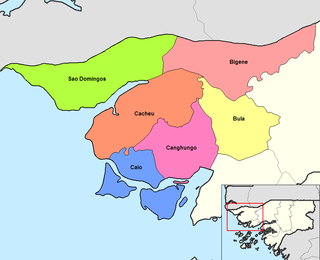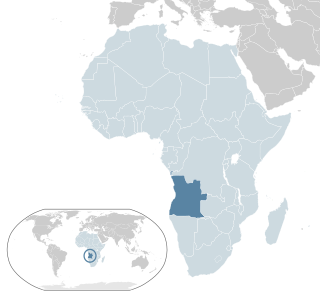| Regions with significant populations | |
|---|---|
| Bissau | |
| Languages | |
| Portuguese, Hebrew | |
| Religion | |
| Judaism |
| Part of a series on |
| Jews and Judaism |
|---|
The history of the Jews in Guinea-Bissau date back at least to the 15th century, when Sephardi Jewish traders and explorers arrived in the region from Portugal. Portuguese Sephardi Jews maintained a presence in colonial Guinea for centuries. The contemporary Jewish community in Guinea-Bissau is small.
During the late 15th century and early 16th century, Portuguese Jews escaping religious persecution in Portugal during the Portuguese Inquisition formed Jewish communities along the coasts of the Upper Guinea from Sierra Leone to Senegal, including what is now Guinea-Bissau. These Portuguese settlers, known as lançados, married local African women and formed families. These mixed-race Black Sephardi communities are often known as Luso-Africans. Much early commerce in along the Upper Guinea coastline was conducted by lançados who sailed to and from S. Domingos, located north of present-day Bissau. Mixed-race Black Sephardi Jews in the region were referred to as filhos de terra and were generally considered "Portuguese". [1]
According to Gideon Behar, the Israeli ambassador to Senegal, Jewish people maintained a continuous presence in Guinea-Bissau until 1943, when the Jewish community was uprooted during the rule of the fascist dictator Antonio de Oliveira Salazar. Guinea-Bissau was then known as Portuguese Guinea, a colony of Portugal. [2]
According to a 2019 report from the United States Department of State, the Jewish community in Guinea-Bissau was small and mostly composed of foreign-born residents. [3]
The region now known as Guinea-Bissau has been inhabited for thousands of years. In the 13th century, it became a province of the Mali Empire that later became independent as the Empire of Kaabu. The region was claimed by Portugal beginning in the 1450s. During most of this period, Portuguese control of the region was limited to a number of forts along the coast. Portugal gained full control of the mainland after the pacification campaigns of 1912–15. The offshore Bijago islands were not colonised until 1936. After independence in 1974, the country was controlled by a single-party system until 1991. The introduction of multi-party politics in 1991, brought the first multi-party elections in 1994. A civil war broke out from 1998 to 1999.

SephardicJews, also known as Sephardi Jews or Sephardim, and rarely as Iberian Peninsular Jews, are a Jewish diaspora population associated with the Iberian Peninsula. The term, which is derived from the Hebrew Sepharad, can also refer to the Jews of the Middle East and North Africa, who were also heavily influenced by Sephardic law and customs. Many Iberian Jewish exiled families also later sought refuge in those Jewish communities, resulting in ethnic and cultural integration with those communities over the span of many centuries.

African Jewish communities include:
Jewish ethnic divisions refer to many distinctive communities within the world's Jewish population. Although considered a self-identifying ethnicity, there are distinct ethnic subdivisions among Jews, most of which are primarily the result of geographic branching from an originating Israelite population, mixing with local communities, and subsequent independent evolutions.
The lançados were settlers and adventurers of Portuguese origin in Senegambia, Cabo Verde, Guinea, Sierra Leone, and other areas on the coast of West Africa. Many were Jews—often New Christians—escaping persecution from the Portuguese Inquisition. Lançados often took African wives from local ruling families, securing protection and advantageous trading ties. They established clandestine trading networks in weaponry, spices, and slaves. This black market angered the Portuguese Crown by disrupting its ability to collect taxes.
The Petite Côte is a stretch of coast in Senegal, running south from the Cap-Vert peninsula to the Saloum Delta, near the border with the Gambia.

Guinea-Bissau Creole, also known as Kiriol or Crioulo, is a creole language whose lexicon derives mostly from Portuguese. It is spoken in Guinea Bissau, Senegal and The Gambia. It is also called by its native speakers as guinensi, kriyol, or portuguis.

Jews of the Bilad al-Sudan describes West African Jewish communities connected to known Jewish communities who migrated to West Africa as merchants for trading opportunities. Various historical records state that at one time, they were present in the Ghana Empire, the Mali Empire, the Mossi Kingdoms and the Songhai Empire, which was then called the Bilad al-Sudan "Land of the Blacks".

Mestiço is a Portuguese term that referred to persons born from a couple in which one was an aboriginal person and the other a European.

São Domingos is both a Sector and a city in the Cacheu Region of Guinea-Bissau. The sector contains the main border checkpoint to Senegal between Jegue, Mpack on the Senegalese.

The history of the Jews in Cape Verde deals with the Jews and Jewish communities in Cape Verde.
Sephardic Bnei Anusim is a modern term which is used to define the contemporary Christian descendants of an estimated quarter of a million 15th-century Sephardic Jews who were coerced or forced to convert to Catholicism during the 14th and 15th century in Spain and Portugal. The vast majority of conversos remained in Spain and Portugal, and their descendants, who number in the millions, live in both of these countries. The small minority of conversos who did emigrate normally chose to emigrate to destinations where Sephardic communities already existed, particularly to the Ottoman Empire and North Africa, but also to more tolerant cities in Europe, where many of them immediately reverted to Judaism. In theory, very few of them would have traveled to Latin America with colonial expeditions, as only those Spaniards who could certify that they had no recent Muslim or Jewish ancestry were supposed to be allowed to travel to the New World. Recent genetic studies suggest that the Sephardic ancestry present in Latin American populations arrived at the same time as the initial colonization, which suggests that significant numbers of recent converts were able to travel to the new world and contribute to the gene pool of modern Latin American populations despite an official prohibition on them doing so. In addition, later arriving Spanish immigrants would have themselves contributed additional converso ancestry in some parts of Latin America.
Eastern Sephardim are a distinctive sub-group of Sephardic Jews mostly descended from Jewish families which were exiled from Iberia in the 15th century, following the Alhambra Decree of 1492 in Spain and a similar decree in Portugal five years later. This branch of descendants of Iberian Jews settled across the Eastern Mediterranean.

The history of the Jews in Madeira spans the entire length of the history of Madeira itself. The history of Madeira begins with the discovery of the islands by Portugal in 1419. Madeira is presently officially the Autonomous Region of Madeira, and is one of the two autonomous regions of Portugal. It is an archipelago situated in the north Atlantic Ocean, southwest of Portugal. Its total population was estimated in 2016 at 289,000. The capital of Madeira is Funchal, which is located on the main island's south coast.
Luso-Africans are people of mixed Portuguese and African ancestry who speak Portuguese. The vast majority of Luso-Africans live in former Portuguese Africa, now referred to as Lusophone Africa, comprising the modern countries of Angola, Guinea-Bissau, Cape Verde, Mozambique, São Tomé and Príncipe, and Equatorial Guinea. A sizable number of Luso-Africans have also settled in Portugal where they form a racial minority. This ethnic identity arose from the sixteenth century as primarily male Portuguese settlers, often Lançados, settled in various parts of Africa, often marrying African women.

The recorded history of the Jews in Angola stretches from the Middle Ages to modern times. A very small community of Jews lives in Angola mostly in the capital city of Luanda with a handful scattered elsewhere of mixed origins and backgrounds. There are also a number of transitory Israeli businesspeople living in Angola.
The history of the Jews in Senegal has its origins in the Jews of Bilad al-Sudan, those Jewish communities in West Africa dating to the 14th century. Today only a small number of Jews live in Senegal, mostly of foreign origin.
The history of the Jews in the Gambia dates back to the 16th and 17th centuries, when Sephardi Jewish explorers and traders came to the region of Senegambia. In contemporary Gambia, a Jewish community of local converts has emerged during the 2010s and 2020s.
The history of the Jews in Sierra Leone date back at least to the 15th century, when Sephardi Jewish traders and explorers arrived in the region from Portugal.
The history of the Jews in Guinea date back at least to the 15th century, when Sephardi Jewish traders and explorers arrived in the region from Portugal. The contemporary Jewish community in Guinea-Bissau is very small.